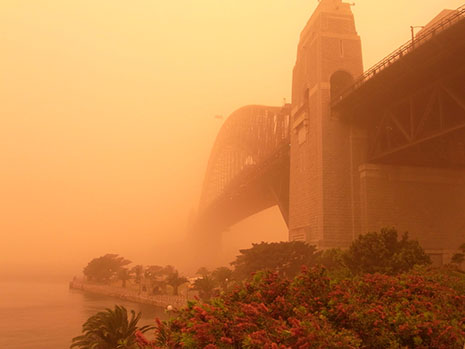I WOKE UP yesterday with the taste of the desert in my mouth; the drought had come to town.
Overnight, tons of topsoil had blown into Sydney from far-off South Australia, bringing with it a rubescent sky and the threat of asthma. Within minutes of its arrival, awed Sydneysiders were sending digital photos of the phenomenon to their familiars in the obviously mistaken belief that no one else had noticed the all-encompassing red cloud. Meanwhile scores of un-awed Sydneysiders were jogging through the stuff. Some were taken to hospital gasping for breath.
By lunchtime a question had begun to exercise the citizens of Australia’s largest city: were the dusty red sails of the Opera House at sunrise a portent of dangerous climate change?
Expert opinion is undecided. Dust storms are a feature of the Australian climate, say the scientists, but equally they don’t normally reach the east coast. Droughts are also common, but the current “big dry” has been particularly tenacious.
Maybe we should just add dust storms to the growing list of things climatologists have warned us are likely to become more intense and more prevalent as climate change really starts to kick in. Like bushfires, cyclones and floods.
As I contemplated the blood-red sky my radio broadcast the news from New York, where the United Nations was hosting the world’s largest ever meeting on climate change by heads of government. As ABC Radio reported, UN Secretary-General Ban Ki-moon told the assembled elite: “Now is your moment to act. Climate change is the preeminent geopolitical and economic issue of the 21st century. We will pay an unacceptable price if we do not act now.”
Whenever I imagine a room full of politicians discussing climate change I think of Fermi’s Paradox.
One day in 1950 the Italian-born nuclear physicist Enrico Fermi was on his way to lunch with some of his colleagues from the Los Alamos National Laboratory. They were discussing whether extraterrestrial life could really be out there.
Fermi was one of the greatest scientists ever to walk on this pale blue dot we call home. He won the Nobel Prize for Physics in 1938, played a key role in the Manhattan Project and was one of the atomic bomb’s many fathers. To say he had an inquisitive mind is probably an understatement. By the time he and his companions were sitting down to lunch, he had become intrigued by the idea.
The universe is very, very big – there are 250 billion stars, for example, in the Milky Way alone – and the Earth couldn’t possibly be unique. He jotted down a few quick calculations – on a napkin, I suppose – and concluded that extraterrestrials should have made contact with Earth long ago. As he exclaimed to his table companions: “Where is everybody?”
Over the years a number of possible solutions to the paradox have been put forward. Maybe we haven’t been looking for long enough, or in the right places, some argue. Maybe they’re out there, others hypothesise, but no one wants to talk to us. Maybe we’re just too stupid to recognise an ET when we see one. Or maybe it’s because communication across light years is nigh on impossible.
Or maybe, runs the least palatable of the proposed solutions, it is in the nature of intelligent life to destroy itself.
The Doomsday Option takes a pretty dim view of complex civilisations and is probably most closely associated with the late Carl Sagan, astrophysicist, author and TV presenter. Its basis is the belief that by the time a civilisation gets to the point where it can make contact with others – either by space travel or radio transmissions – it’s pretty much on the verge of buggering things up. Sagan, of course, reckoned on a nuclear Armageddon, but then he died before much of the science on the greenhouse effect had been developed.
By the end of the day in Sydney strong winds had swept the red dust either out to sea or up the coast to annoy Brisbane. The night sky was almost clear, certainly clear enough to see the stars. Looking up at them I wondered what Sagan and Fermi would have made of Sydney’s day in the red.
And I also wondered what will happen this December in Copenhagen when our species finally comes together to do something about climate change. Evidently there are only 2500 points of disagreement still left in the negotiating text. •




